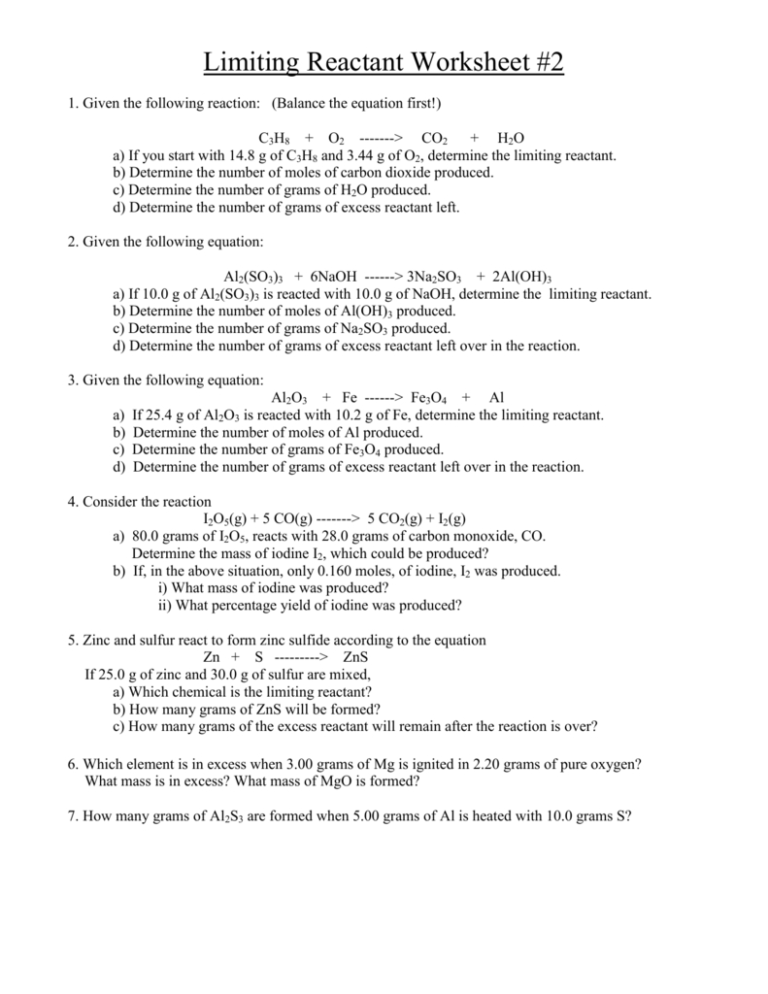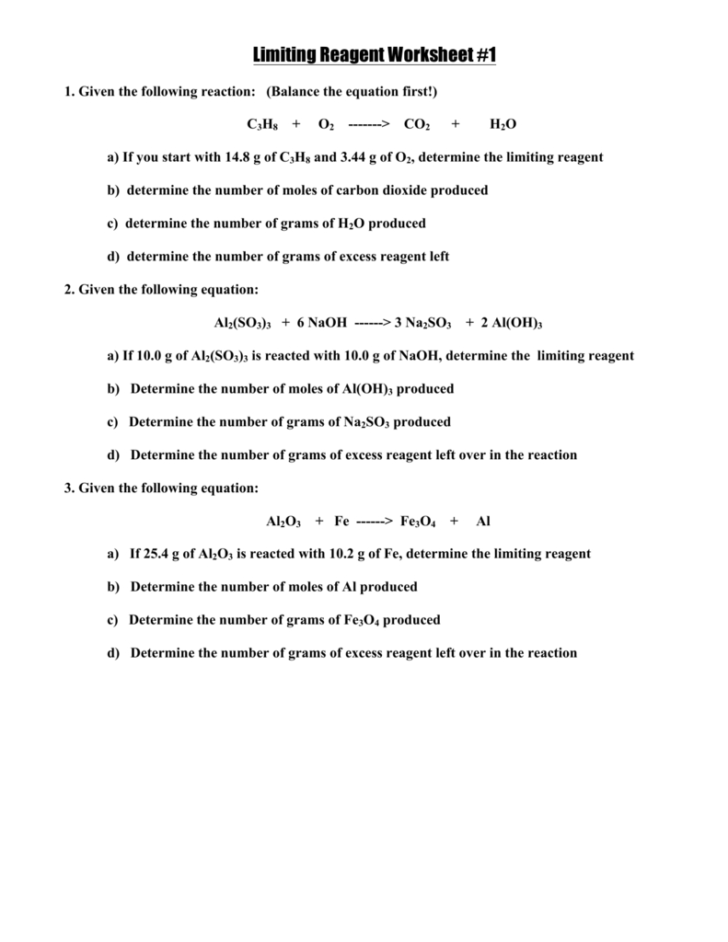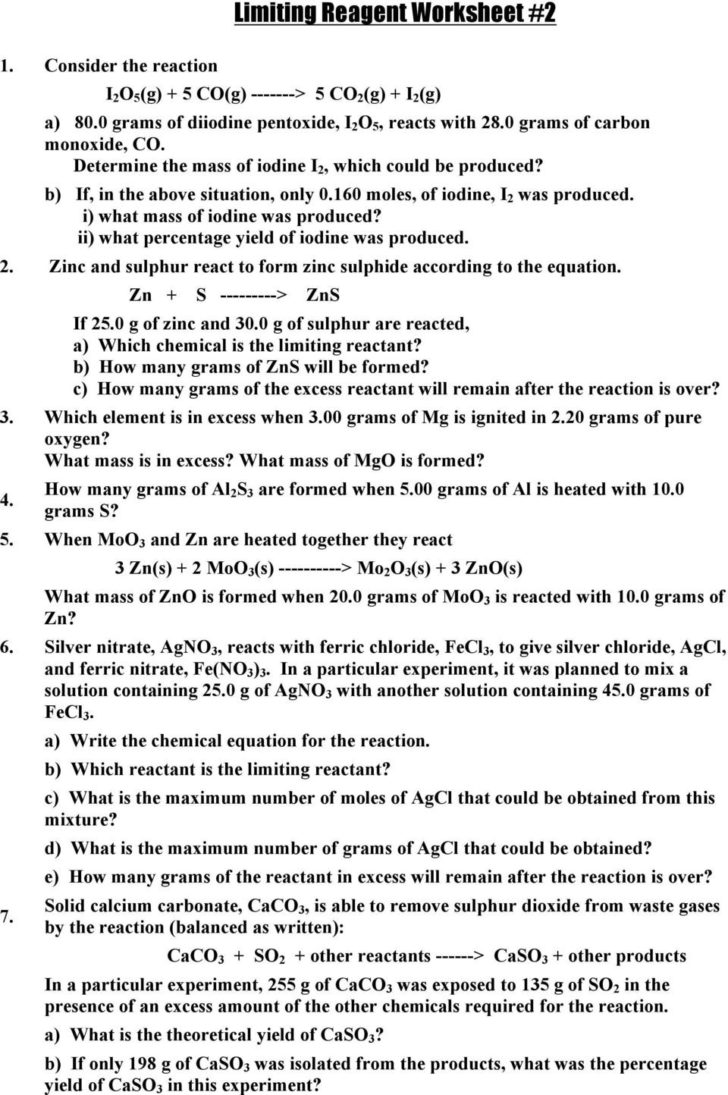Limiting Reagent Worksheet 2 Answers - What mass of calcium hydroxide is formed when 10.0 g of cao + h2o → ca(oh)2 calcium oxide reacts with 10.0 g of water? Because sodium iodide is the reagent that causes 8.51 grams of sodium. What is the limiting reagent in the reaction described in problem 2? Both of the following give you the same answer. How many moles of nh3 can be produced from the reaction of 28 g of n2 ? Limiting reagent worksheet #1 1. Limiting reagent worksheet using your knowledge of stoichiometry and limiting reagents, answer the following questions: What is the limiting reactant if 2.2 g of mg is reacted with 4.5 l of oxygen at stp?
Limiting reagent worksheet using your knowledge of stoichiometry and limiting reagents, answer the following questions: How many moles of nh3 can be produced from the reaction of 28 g of n2 ? What mass of calcium hydroxide is formed when 10.0 g of cao + h2o → ca(oh)2 calcium oxide reacts with 10.0 g of water? What is the limiting reactant if 2.2 g of mg is reacted with 4.5 l of oxygen at stp? Because sodium iodide is the reagent that causes 8.51 grams of sodium. Limiting reagent worksheet #1 1. Both of the following give you the same answer. What is the limiting reagent in the reaction described in problem 2?
Limiting reagent worksheet using your knowledge of stoichiometry and limiting reagents, answer the following questions: What is the limiting reactant if 2.2 g of mg is reacted with 4.5 l of oxygen at stp? How many moles of nh3 can be produced from the reaction of 28 g of n2 ? Both of the following give you the same answer. What is the limiting reagent in the reaction described in problem 2? Limiting reagent worksheet #1 1. Because sodium iodide is the reagent that causes 8.51 grams of sodium. What mass of calcium hydroxide is formed when 10.0 g of cao + h2o → ca(oh)2 calcium oxide reacts with 10.0 g of water?
Limiting Reactants Worksheet GCSE Chemistry Beyond Worksheets Library
How many moles of nh3 can be produced from the reaction of 28 g of n2 ? Limiting reagent worksheet #1 1. What is the limiting reactant if 2.2 g of mg is reacted with 4.5 l of oxygen at stp? What is the limiting reagent in the reaction described in problem 2? Limiting reagent worksheet using your knowledge of.
SOLUTION Moles limiting reagent and molarity worksheet with answers
Because sodium iodide is the reagent that causes 8.51 grams of sodium. Both of the following give you the same answer. What is the limiting reagent in the reaction described in problem 2? Limiting reagent worksheet using your knowledge of stoichiometry and limiting reagents, answer the following questions: What mass of calcium hydroxide is formed when 10.0 g of cao.
Limiting Reagents 2 Chemsheets Answers
What is the limiting reagent in the reaction described in problem 2? How many moles of nh3 can be produced from the reaction of 28 g of n2 ? Limiting reagent worksheet using your knowledge of stoichiometry and limiting reagents, answer the following questions: Limiting reagent worksheet #1 1. Both of the following give you the same answer.
Limiting Reagent Practice Problems With Answers Limiting Rea
Limiting reagent worksheet #1 1. Both of the following give you the same answer. What is the limiting reactant if 2.2 g of mg is reacted with 4.5 l of oxygen at stp? How many moles of nh3 can be produced from the reaction of 28 g of n2 ? What mass of calcium hydroxide is formed when 10.0 g.
Limiting Reagent Worksheets
How many moles of nh3 can be produced from the reaction of 28 g of n2 ? What mass of calcium hydroxide is formed when 10.0 g of cao + h2o → ca(oh)2 calcium oxide reacts with 10.0 g of water? Because sodium iodide is the reagent that causes 8.51 grams of sodium. What is the limiting reactant if 2.2.
Free Printable Limiting Reagent Worksheets Worksheets Library
How many moles of nh3 can be produced from the reaction of 28 g of n2 ? What mass of calcium hydroxide is formed when 10.0 g of cao + h2o → ca(oh)2 calcium oxide reacts with 10.0 g of water? Because sodium iodide is the reagent that causes 8.51 grams of sodium. Limiting reagent worksheet #1 1. What is.
Limiting Reagent Worksheet Answer Key With Work —
What is the limiting reagent in the reaction described in problem 2? Because sodium iodide is the reagent that causes 8.51 grams of sodium. Limiting reagent worksheet #1 1. What mass of calcium hydroxide is formed when 10.0 g of cao + h2o → ca(oh)2 calcium oxide reacts with 10.0 g of water? Both of the following give you the.
Limiting Reagent Worksheet 2 Answers
What mass of calcium hydroxide is formed when 10.0 g of cao + h2o → ca(oh)2 calcium oxide reacts with 10.0 g of water? Both of the following give you the same answer. How many moles of nh3 can be produced from the reaction of 28 g of n2 ? Because sodium iodide is the reagent that causes 8.51 grams.
Solved 1. 2. 3. 4. 5 Limiting Reagent Worksheet 2 Consider
Both of the following give you the same answer. What is the limiting reactant if 2.2 g of mg is reacted with 4.5 l of oxygen at stp? How many moles of nh3 can be produced from the reaction of 28 g of n2 ? Limiting reagent worksheet using your knowledge of stoichiometry and limiting reagents, answer the following questions:.
Limiting Reagent Worksheets 1 Answers
What is the limiting reactant if 2.2 g of mg is reacted with 4.5 l of oxygen at stp? How many moles of nh3 can be produced from the reaction of 28 g of n2 ? What mass of calcium hydroxide is formed when 10.0 g of cao + h2o → ca(oh)2 calcium oxide reacts with 10.0 g of water?.
Both Of The Following Give You The Same Answer.
Limiting reagent worksheet #1 1. Because sodium iodide is the reagent that causes 8.51 grams of sodium. How many moles of nh3 can be produced from the reaction of 28 g of n2 ? What is the limiting reactant if 2.2 g of mg is reacted with 4.5 l of oxygen at stp?
What Mass Of Calcium Hydroxide Is Formed When 10.0 G Of Cao + H2O → Ca(Oh)2 Calcium Oxide Reacts With 10.0 G Of Water?
Limiting reagent worksheet using your knowledge of stoichiometry and limiting reagents, answer the following questions: What is the limiting reagent in the reaction described in problem 2?









